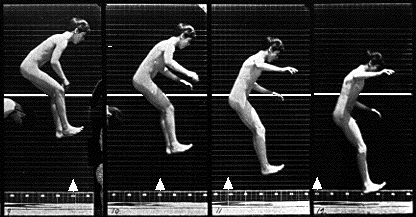
Fashioning the Body: Versions of the Citizen, the Self, and the Subject
The Evergreen State College | Fall 2007-Winter 2008
User Login |
Corpus - Feminist Video Art
Vertical Roll by Joan Jonas
I don’t know a lot about the difference between video and film, but isn’t the vertical roll, like that depicted here, something from film, not video? The introducer said that Jonas was using the roll and the noise to disrupt our gaze over her body, and that there was an idea of being inside a box with early video art. Does the body within the roll represent a body on film, and the face outside the roll represent some sort of agency or looking-ness (as opposed to gaze) possible with video? When watching it, I really felt that the face represented something positive, of escaping. But from what? The disruption of the roll, or from being the object of gaze? But the face is outside the roll, which was supposed to disrupt the gaze. I guess I’m a bit confused about the message of this work, though I actually liked it a lot. I didn’t find it that difficult, really, after I got used to the sound. Female Sensibility by Lynda Benglis What’s very interesting to me here is the way that bodies and voices are separated. The women in the film aren’t objectified, I don’t think. This was before the straight male fascination with / eroticization of lesbians, wasn’t it? The bodies exist in a bright, colorful space, but it’s a space without sound. The voices exist in a misogynistic space (that of radio), but we don’t see bodies associated with it. It seems that the bodies we see have escaped from the misogynist space of the sound we hear. Or, perhaps not, because they may be rebelling against it, which is different from existing outside of it. Through the Large Glass by Hannah Wilke I don’t know enough about the art world / Duchamp / the Large Glass to really know what Wilke was trying to do with this piece. I thought what Bridget said about her career was very interesting though (I think it was about Wilke’s career, though it was a bit confusing which artist she was referring to at the time). The idea was that Wilke was thought to just be an exhibitionist, and to be too pretty, and this made her less of an artist in people’s eyes. But, when she was dying of cancer, and documented it with video, this somehow legitimated all her previous work. Why is it that a beautiful woman who shows her body is automatically not an artist? And why is it that, if she is later dying, suddenly she is an artist? There are some really interesting discourses about women’s bodies going on here. If she wasn’t an artist because she was too pretty before, is she an artist later because cancer makes her body less desirable? The East is Red, the West is Burning by Martha Rosler What I like about this piece (aside from how it’s funny) is how it ties imperialism to eating. The woman’s body is quite literally in the kitchen in this piece, but this doesn’t mean that it isn’t implicated in global politics. What I want to know is, why was Rosler wearing sunglasses? It seems important in some way that we can’t see her eyes. Technology/Transformation: Wonder Woman by Dara Birnbaum Apparently, a woman’s body needs to go through an explicit transformation to become the body of a hero, to become strong. The song at the end is also very interesting – “Shake your wonder maker.” Her wonder maker is a physical part of her body that can be shaken? The scene where she deflects bullets with her bracelets raises questions of prosthetics. How much of her power comes from her costume, and what does this say about a female hero? (Though I want to point out that Wonder Woman exists in the same universe as Batman, whose powers come entirely from his costume/his prosthetics.)
Submitted by Spencer on Sun, 11/11/2007 - 12:21pm. Spencer's blog | login or register to post comments | printer friendly version
|
Who's onlineThere are currently 0 users and 1 guest online.
Events
|
|||||||||||||||||||||||||||||||||||||||||||||||||